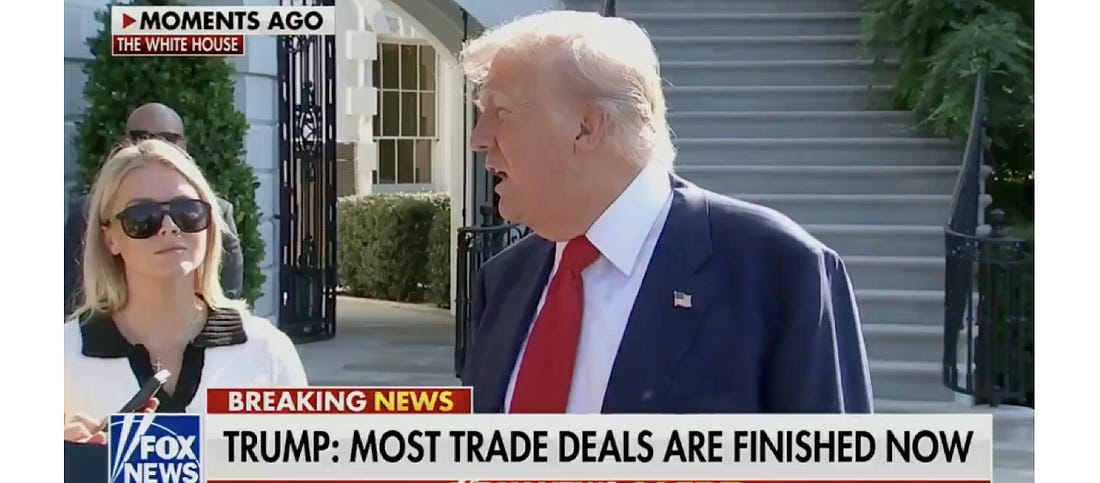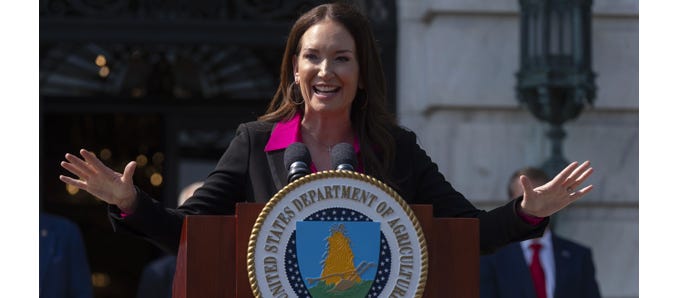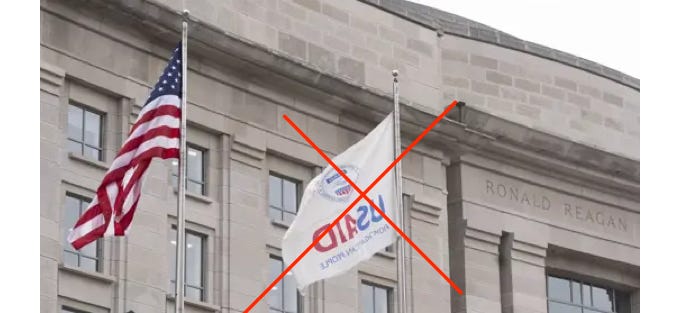C&C. USDA SCATTERED. Queen for a Day- DOJ. Working Weekends.
July 27 | Posted by mrossol | Administrative State, Childers, Europe, Liberal Press, Pharma, Pushing Back, Trump, VaccineNYT retreats to “Republicans pounce” as Maxwell dishes; vaccine liability bill gains steam; Trump eyes tariff rebates, wrecks EU weekend; USDA scattered; major court win clears USAID overhaul; more.
Source: SCATTERED ☙ Sunday, July 27, 2025 ☙ C&C NEWS
WORLD NEWS AND COMMENTARY
🔥🔥🔥
Republicans react! Not just any Republicans, but right-wing influencers. Yesterday, the New York Times ran its latest deplorable Epstein story below the headline, “Right-Wing Influencers Say Ghislaine Maxwell Is Key to Unlocking Epstein Case.” But it didn’t hit like they’d hoped.
“Republicans React!” is the dumbest media trope there is. It is media sleight-of-hand intended to turn a story away from the underlying facts and toward the emotional response of the political right, framing every conservative concern as performative outrage rather than substantive critique.
Imagine— a top-of-fold Times story about what Charlie Kirk said about the truly historic questioning of the most important Epstein witness alive. It’s like covering Watergate by quoting what Nixon’s critics said on AM radio.
“Republicans pounce” is lazy propaganda. The low-effort maneuver lets journalists acknowledge a major development without interrogating its deeper meaning or unsettling implications. Especially when those implications might implicate the institutional elite or their political allies.
Instead of focusing on what Ghislaine Maxwell might have revealed, or the implications of the DOJ finally interviewing its best Epstein witness, the narrative spotlighted MAGA influencers “pouncing” or “seizing” on developments, as if the real story is the choreography of Republican indignation on Twitter.
Of the many problems with this sort of unambitious storytelling, one thing stands out: It doesn’t work anymore.
🔥 Gallup and Pew surveys show confidence in mainstream media at historic lows, particularly among independents and conservatives. Weird! Consider Gerard Butler’s anguished Wall Street Journal op-ed from March:
“The outrage about Trump is as furious,” Butler wrote, “as it is futile. No one cares anymore.” He’s right. The moral indignation that legacy media outlets once wielded like a sword now lands with the full force of a pool noodle. More, these tactics have become so overused that they have been turned on their heads and have become the smoke that proves a fire is burning.
In nearly every case where corporate media unleashed this trope, not only did the story turn out to have legs, but it has almost always spectacularly backfired on Democrats. “Republicans pounce on Hunter laptop leak.” Covid school closures fueled “right-wing outrage” and were only based on “Republican talking points.” After a transsexual boy raped a Loudon County girl in a high-school bathroom, media reported “right-wing mobilization around trans issues.” And “Republicans lash(ed) out” at the IRS Tea-Party targeting scandal.
Never forget that for two years or more, the Times’ default covid origins headline sneered, “Republicans promote baseless lab theory.”
Just like Pavlov’s bell made the dobermans salivate, “far-right conspiracy” now cues readers to pay closer attention. Media has created its very own dog whistle.
Cheap-fake chickens, welcome back to the roost.
🔥 But even after all that, the Times still fumbled its narrative hand grenade and accidentally blew a hole in its own containment wall. Trying desperately to frame the Ghislaine Maxwell interview as a fringe, right-wing sideshow, it inadvertently showcased how serious —and bipartisan— the interest really is.
Far from unhinged, the story’s quotes from figures like Benny Johnson (“This is what transparency looks like”) and Jack Posobiec (“Receipts and names”) are direct, measured, and honestly, were more journalistic than the story itself. Even Charlie Kirk’s so-called gotcha (“Can we trust Ghislaine Maxwell? Probably, but also probably not”) was a textbook example of cautious, rational skepticism.
It smelled more like panic. The Times tried to signal that the right was frothing over a non-story, but instead, it documented that conservatives are asking the exact same questions the press should’ve been asking all along. In trying to minimize Maxwell’s importance, they reinforced it. The story didn’t even come close to debunking the Epstein scandal.
🔥 The Times is still obsessing over Maxwell’s motives for testifying. As I noted yesterday, Maxwell’s credibility isn’t the issue. All witnesses, especiallycooperators, are situated on a sliding scale of reliability, subject to corroboration and cross-examination. That’s not new.
What is new, and what actually matters, is that her interview signaled a beginning, not an end. It is new, improved launch pad for the realinvestigation that should’ve been launched years ago; before the cameras at MCC went dark, before the files were buried, and before the public was told to move along.
Instead of obsessing over whether Maxwell is trustworthy, the real questions are: Why now? And what comes next? The moronic press, reflexively trying to micromanage the narrative, completely missed the significance of the moment.
🔥 The first interview with Ghislaine Maxwell —ten hours over two days—almost certainly wasn’t about digging to the bottom of the Epstein conspiracy in a single sitting.
It was almost certainly a proffer session. A proffer session is an interview where the witness gets limited immunity, and the DOJ gets to test the waters: how much is she willing to give, how credible does she sound, and what can be verified or leveraged?
The DOJ’s internal guidance on proffer sessions is informally called the “Queen for a Day interview.” These are informal but highly structured opportunities for a potential cooperating witness to preview their testimony—not under oath, but typically under a proffer agreement that shields their statements from being used against them (unless they lie).
The DOJ uses these interviews to assess three things: credibility, scope of knowledge, and strategic value. Ghislaine’s ten-hour interview was a serious first step in a process that could lead to broader charges, corroborating witnesses, or plea negotiations.
All of this procedural background —the likely purpose of the interview, the mechanics of a proffer session, the strategic significance of Maxwell’s cooperation— could have been explained by any competent journalist if the goal were to inform readers.
But none of that critical background made any of the articles— because explaining the machinery might make readers expect more justice against more defendants. Instead, all reporters want to explain is what Jack Posobiec said.
As you already know, corporate media is worse than useless.
💉💉💉
On Thursday, local KAWC ran a story headlined, “Gosar reintroduces bill to let people sue vaccine makers.” This week, Representative Paul Gosar (R-Az.) re-filed a bill to permanently end all vaccine liability protection. His press release was titled, “Gosar Reintroduces Legislation to Sue Big Pharma for Vaccine Injuries.”
Last year, it was Harriet Hageman’s turn. Harriet’s bill died before it got anywhere. This time, maybe the most promising development is the growing list of co-sponsors. According to Gozar’s presser, he’s got Representatives Biggs (AZ), Boebert, Brecheen, Burchett, Burlison, Collins, Crane, Davidson, Donalds, Greene, Hageman, Harris (MD), Higgins, Jackson (TX), Luna (FL), Mace, Massie, Miller (IL), Mills, Moore (AL), Nehls, Norman, Ogles, Roy, Self, Spartz, Steube, and Weber.
This new bill is in addition to Rep. Thomas Massie’s bill to repeal the PREP Act filed earlier this month.
I’ll ask again: If vaccines are safe and effective, why do they need liability protection in the first place? It’s like saying, I’m going to punch you in the face. I promise it won’t hurt at all. But even if it does, you can’t sue me.
Let’s not kid ourselves. Gosar’s bill won’t pass, and he knows it. But bless him anyway.
Every new co-sponsor is another crack in the dam. Every refiled bill keeps the issue alive. When the public’s demands to revoke vaccine liability protection reach cacophony, something will eventually give. Maybe not this year, maybe not next. But the pressure is building like a boiler with a stuck release valve. And when that glorious moment does finally come, the people who kept pounding, like Reps. Gosar, Massie, and Hageman, won’t be “fringe.”
They’ll be the first-movers in what’s “suddenly and unexpectedly” become mainstream.
Procedurally, the next test for a bill like Gosar’s is whether it survives committee review. Most bills quietly succumb to the bureaucratic virus in committee. If leadership sends a bill to a hostile “federal workforce” subcommittee and it never even gets a hearing, that signals it’s getting quietly choked out in the crib.
But if it gets assigned to a relevant committee (like the House Energy & Commerce or Judiciary committees), and picks up momentum by getting a markup session or even a hearing, that’s when we’ll know it’s gaining traction.
Gosar’s bill matters even if it doesn’t pass during this term. Clearing the committee bottleneck will be the canary in the coal mine that the Overton Window is shifting. We’ll await further developments with great interest.
🔥🔥🔥
On Friday, Barrons ran a delicious story headlined, “Trump to Meet With EU Sunday, Tariff Rebates Are Possible for Some Americans.” While boarding Air Force One headed to Scotland to negotiate a trade deal with the entire European Union, Trump teased a possible tax refund from ballooning tariff revenues.
Right Angle News Network (@Rightanglenews) on X
“We have so much money coming in from tariffs,” President Trump said, “that a little rebate for people of a certain income level would be very nice. The big thing we want to do is pay down debt.”
Experts said it was impossible. They said it could never happen. They said it would plunge the country into depression.
Rebate talk is good, but consider this remarkable fact: Trump is meeting with the Europeans, including several heads of state, on a Sunday. What that says (to me) is that the Europeans politely declined weekday meetings because their combined calendars were just too full of croissant conferences and insanely bureaucratically incompatible, so Trump said fine, let’s just get together on the weekend.
The U.S. president calling a multi-nation summit on a non-workday is a move soaked in dominance and disregard for protocol. Checkmate.
Trump might very well be the hardest-working president in history. In modern, non-wartime history, no other president has ever made 2am whipping calls on random budget bills and held Sunday trade summits. Trump isn’t just governing by an active presidential rulebook. He’s compressing two full presidential terms into one.
🔥🔥🔥
Thursday, Politico ran a great story headlined, “USDA reorganization will move most of its Washington staff ‘closer to’ farmers.” The sub-headline explained, “Agriculture Secretary Brooke Rollins is closing several D.C.-area buildings but notably will not pursue a large-scale reduction in force.”
The USDA is packing up its Washington operation and heading for the heartland. In a sweeping reorganization, Secretary Rollins announced the closure of nearly every D.C.-area USDA facility except two, relocating thousands of staff to Salt Lake City, Fort Collins, Indianapolis, Kansas City, and Raleigh. No mass firings because, Rollins casually noted, over 15,000 employees have already left under the administration’s deferred resignation plan. And who knows how many more will rage-quit rather than move to flyover country.
Translation: they are literally draining the Swamp.
The move also cuts costs, by slashing D.C.-area salary premiums, which hover around an eye-watering +34%. The federal workforce, long clustered in deep-blue echo chambers and Soviet-style marble hallways, is being scattered across the map.
Critics grumbled about morale and oversight, and hilariously called it a “power concentration move.” That’s newspeak. “De-centralization” is somehow “power concentration” now.
And it’s not just USDA. The FBI is also making a similar move, shifting major operations out of its bunker-like Hoover Building in DC to a sprawling new facility in Greenbelt, Maryland— a location chosen not for prestige, but for logistics, space, and strategic dispersion. Like the USDA relocation, the FBI’s reorganization dilutes the concentration of long-entrenched D.C. insiders who’ve grown comfortable with proximity-as-power.
This is the first sign of permanent Swamp-draining; literal, physical moves that can’t be easily reversed by future administrations. Once the blob is relocated, it will settle in and won’t even want to move back. Once local jurisdictions enjoy the benefits from hosting large regional federal hubs, they’ll hold onto them like grim death.
It’ll take decades to reverse, if it is even possible.
By scattering the agencies, Trump’s not just shrinking the swamp. He’s draining its ability to reconstitute itself. They can win an election and retake the White House— but if the permanent bureaucratic power centers are 900 miles away, good luck rebuilding the Deep State in time for midterms.
Now do the intelligence agencies. Break them into pieces and scatter them to the winds.
⚖️⚖️⚖️
Finally, President Trump enjoyed another major court victory this week. MSN ran the story yesterday, below the headline, “Judge dismisses lawsuits against Trump’s dismantling of USAID.” It’s bigger than the USAID cases, as the story was forced to admit.
“For now,” MSN said, “the judge’s 37-page ruling clears the path for further dismantling of USAID’s operations unless higher courts intervene.” Because the judge found that the court lacks jurisdiction to stop the Executive Branch reorganization, the decision could ripple through many other pending lawsuits.
“The judge’s finding that the plaintiffs lacked jurisdiction,” MSN soberly reported, “could signal the fate of similar legal challenges pending in federal court.” Think dominoes.
Trump is largely winning in court across the board. The rulings against Trump so far —like union contract voiding, foreign aid freezes, and law firm blacklists— are mostly procedural defeats or First Amendment overreaches, not structural losses. They’re more like frontline skirmishes, not any major setbacks to Trump’s battlefield lines. While they have shown that courts, including some conservative jurists, were willing to push back when the administration overreached or cut corners, they haven’t stopped the broader strategic momentum at all.
As this USAID case aptly demonstrates, all Trump’s strategic imperatives —reorganizing the administrative state, shifting regulatory authority, asserting unitary executive power, centralizing foreign policy, and dismantling entrenched bureaucracies— are still moving forward, often with court support or judicial deference.
With everything cooking at a hot boil, next week —my final week of “vacation”— promises to be scorching. I can’t wait.
Have a blessed Sunday! Thank you once again for your continuing loyal support. I’ll be right back here in the morning for another terrific installment of essential news and commentary. Till then.
Don’t race off! We cannot do it alone. Consider joining up with C&C to help move the nation’s needle and change minds. I could sure use your help getting the truth out and spreading optimism and hope, if you can:☕ Learn How to Get Involved 🦠
How to Donate to Coffee & Covid
Twitter: jchilders98.
Truth Social: jchilders98.
MeWe: mewe.com/i/coffee_and_covid.
Telegram: t.me/coffeecovidnews
C&C Swag! www.shopcoffeeandcovid.com














Leave a Reply
You must be logged in to post a comment.